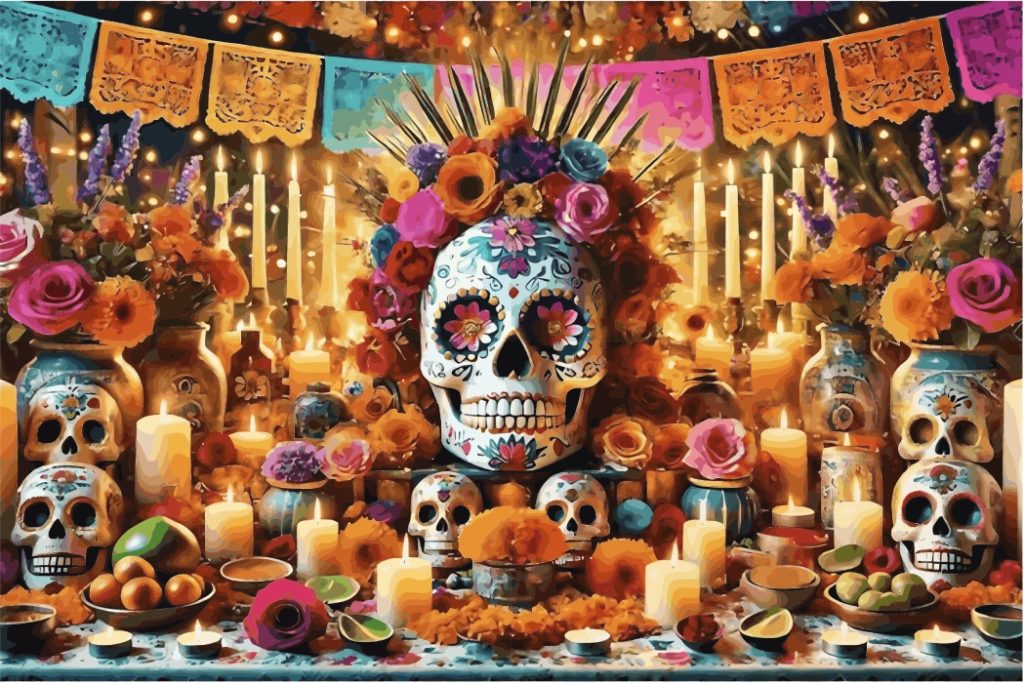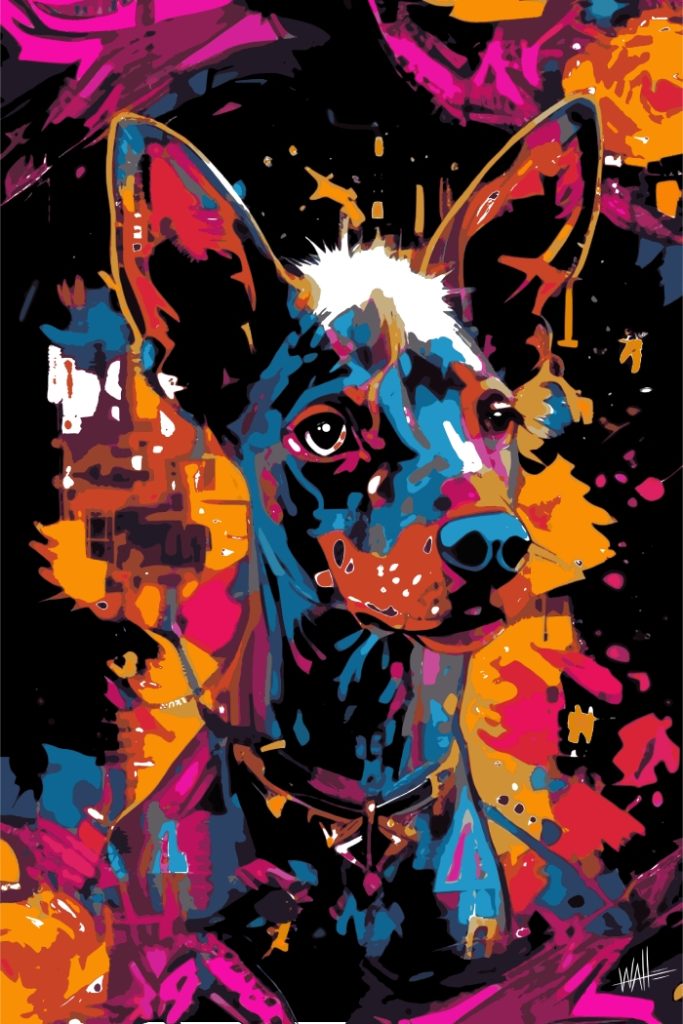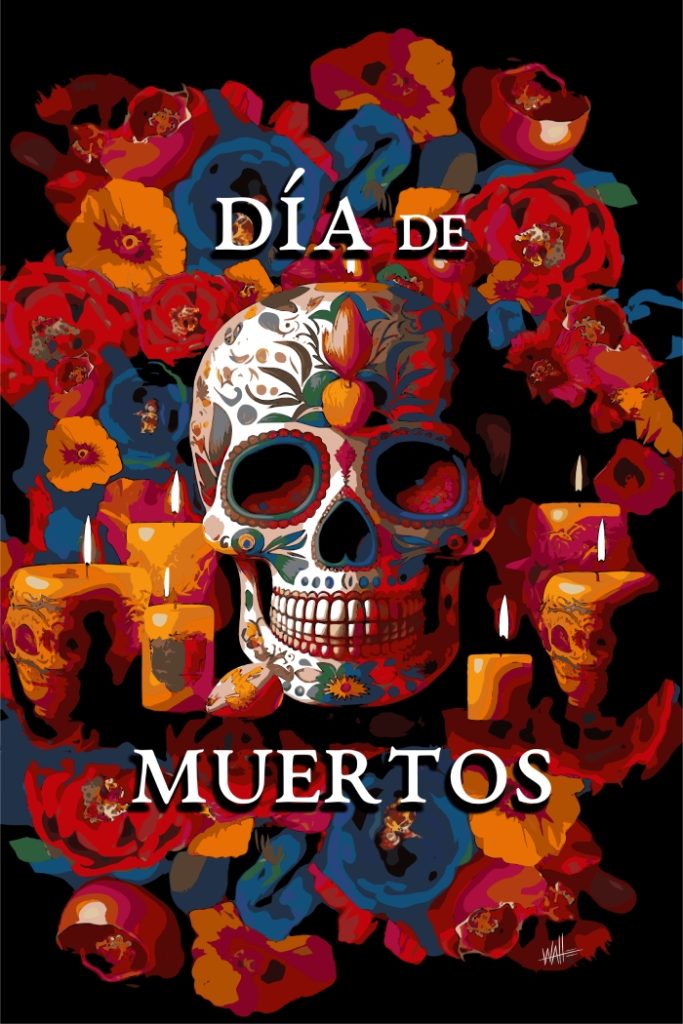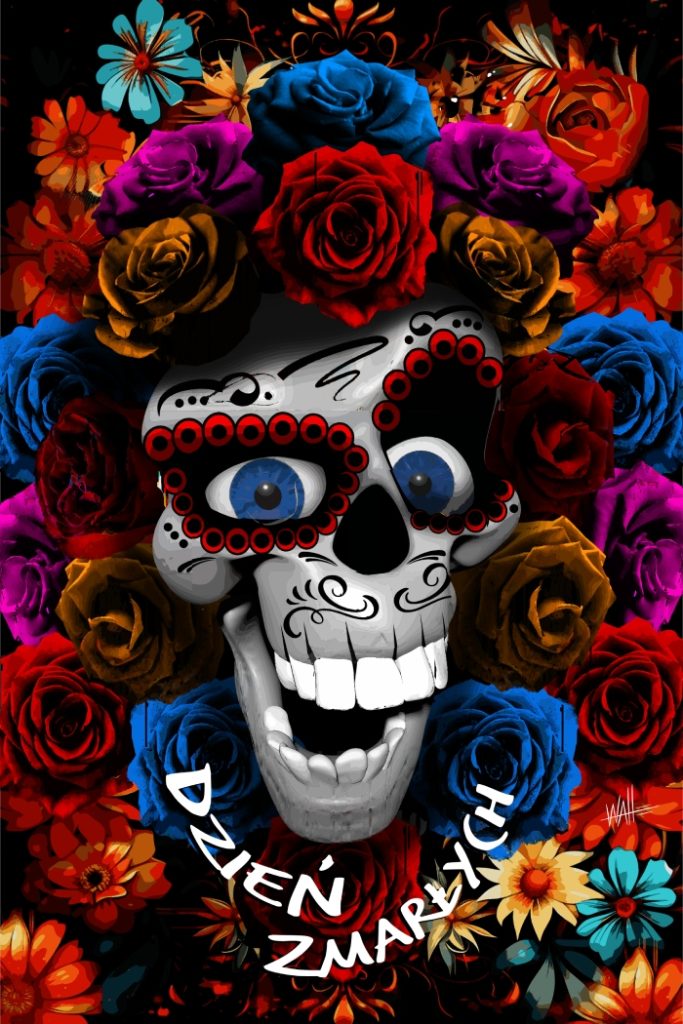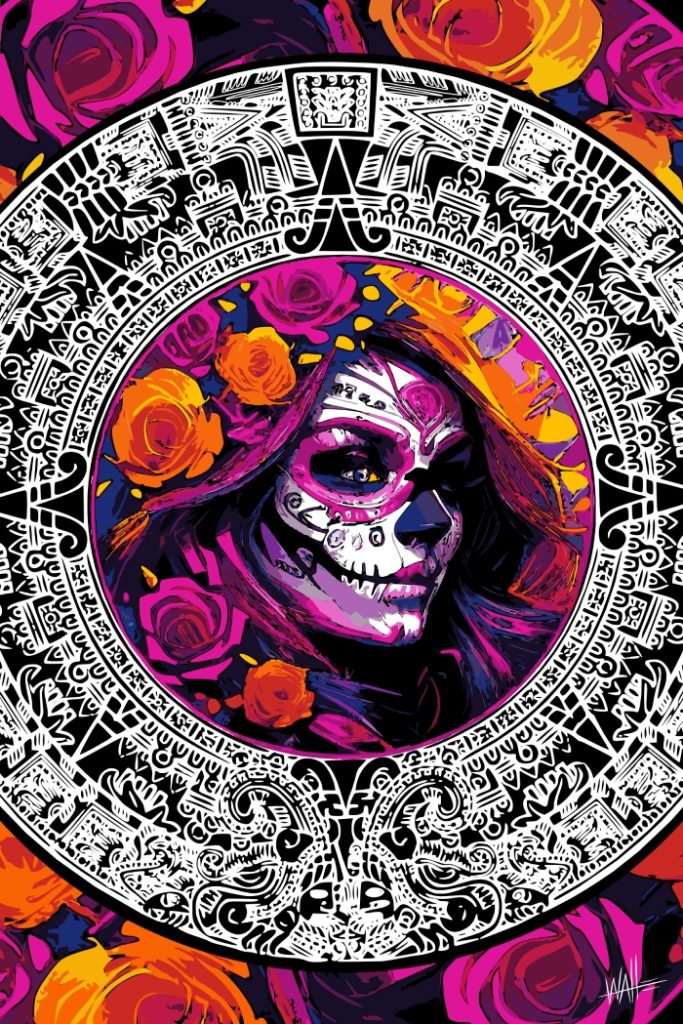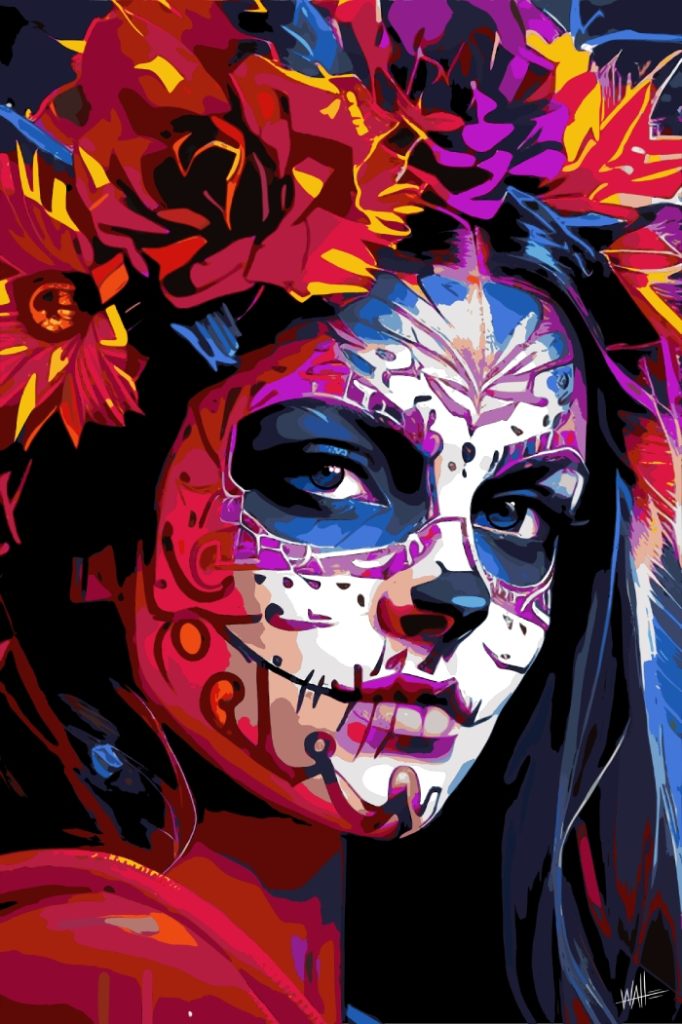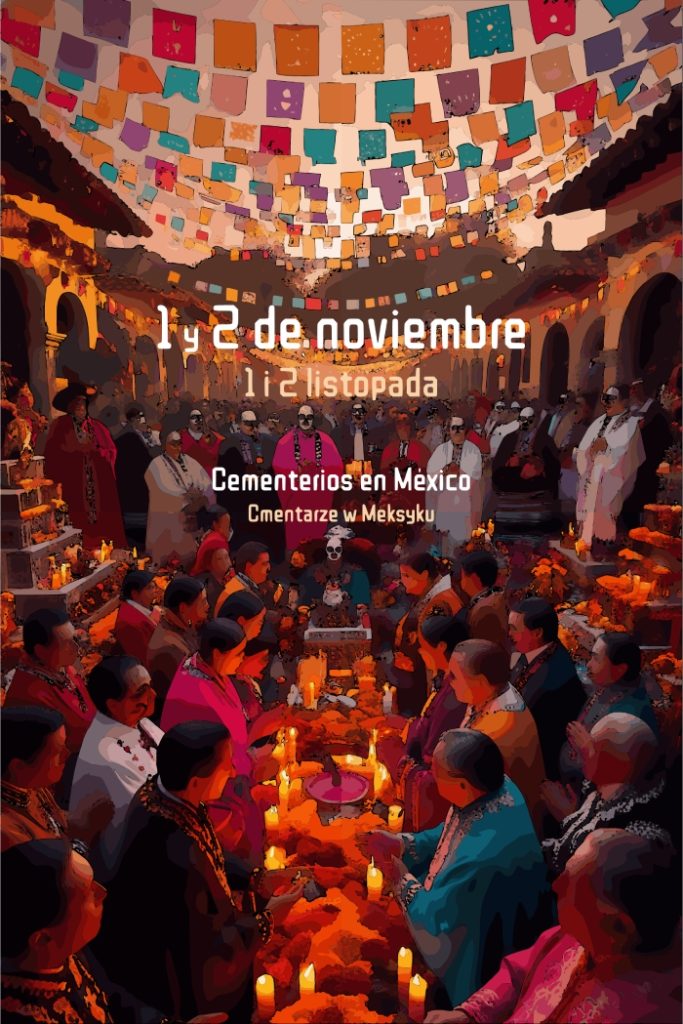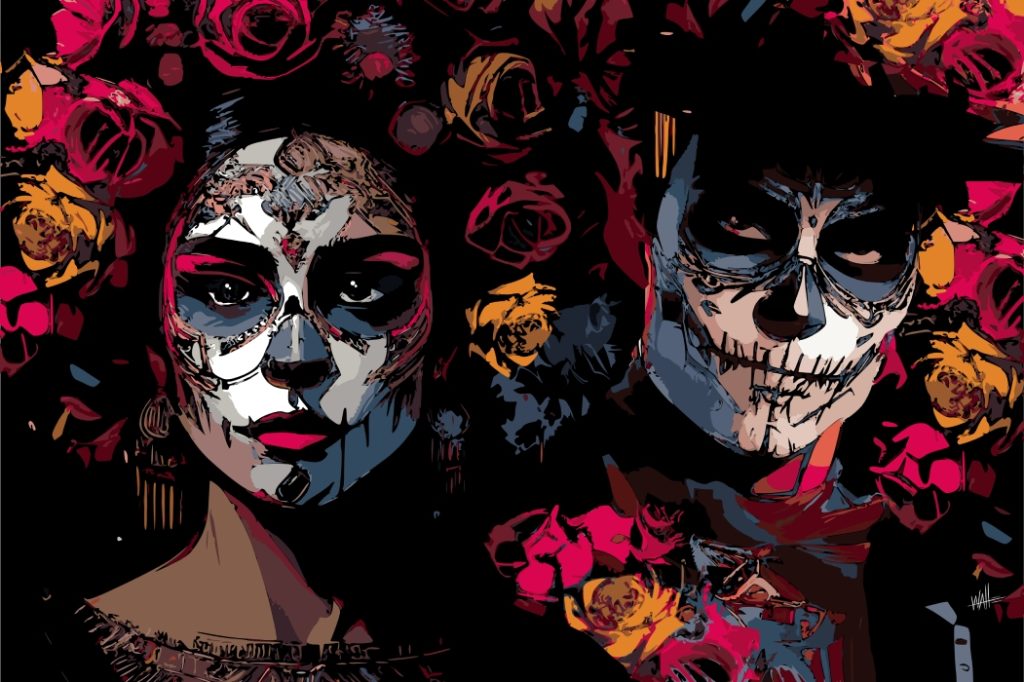
Key Elements of the Celebration
Today, the Day of the Dead is characterized by elements that combine both pre-Hispanic and Catholic symbolism:
- Altars and Offerings: Altars are the heart of the celebration, where photographs, candles, marigolds (the “flower of the dead”), food, drinks, and items the deceased enjoyed in life are placed. Each item on the altar has meaning: candles represent a path to guide souls back, marigolds use color and scent to attract them, and food and drinks allow the dead to enjoy a feast during their visit.
- Bread of the Dead and Sugar Skulls: Pan de muerto (bread of the dead) symbolizes the departed, with shapes that resemble bones and tears. Sugar skulls carry the names of the deceased and sometimes of the living, as a reminder that death is a part of life.
- La Catrina: This iconic figure, created by artist José Guadalupe Posada and popularized by Diego Rivera, represents mockery towards the wealthy class of the time and symbolizes the equality of all in death. Dressed elegantly, La Catrina shows that death equalizes everyone, regardless of social status.
- Perforated Paper and Calaveritas Literarias: Colorful perforated paper symbolizes joy and the wind, one of the four essential elements on the altars. Calaveritas literarias are humorous satirical verses that imagine living people as if they were dead, and they have become a unique literary tradition for this festival.
The Profound Meaning of the Day of the Dead
For Mexicans, the Day of the Dead is more than a celebration; it is an act of love and remembrance for those who have passed. By building an altar and preparing offerings, a space of communication is created between generations, where the living celebrate the lives of those in the afterlife and reaffirm their own place in the cycle of existence.
UNESCO recognized the importance of this tradition by declaring it an Intangible Cultural Heritage of Humanity in 2008, highlighting its ability to strengthen identity and cultural belonging. This festivity, despite its growing global popularity, remains unique to Mexico, filled with mysticism, color, and a profound reverence for life and death.
The Day of the Dead Today
Though today this celebration has gained international popularity and been adapted by other cultures, in Mexico, it has preserved its essence. In towns and cities across the country, families continue to build altars, visit cemeteries, and gather to celebrate the lives of those who have passed. This celebration brings entire communities together in a space where memories and love for those who have departed remain alive, reaffirming the Mexican belief that death is not an end but a continuation of existence.
Główne Elementy Święta
Dziś Dzień Zmarłych charakteryzuje się elementami, które łączą zarówno symbolikę prehiszpańską, jak i katolicką:
Perforowany Papier i Calaveritas Literarias: Kolorowy perforowany papier symbolizuje radość i wiatr, jeden z czterech elementów niezbędnych na ołtarzach. Calaveritas literarias to humorystyczne, satyryczne wierszyki, które wyobrażają żywych, jakby byli martwi, i stały się unikalną literacką tradycją tego święta.
Ołtarze i Ofiary: Ołtarze są sercem obchodów, gdzie umieszcza się zdjęcia, świece, aksamitki (kwiat zmarłych), jedzenie, napoje i przedmioty, które zmarli lubili za życia. Każdy element ołtarza ma swoje znaczenie: świece wskazują drogę duszom, aksamitki przyciągają je kolorem i zapachem, a jedzenie i napoje pozwalają zmarłym cieszyć się ucztą podczas ich wizyty.
Chleb Zmarłych i Cukrowe Czaszki: Pan de muerto (chleb zmarłych) symbolizuje zmarłych, z kształtami przypominającymi kości i łzy. Cukrowe czaszki noszą imiona zmarłych, a czasem żywych, jako przypomnienie, że śmierć jest częścią życia.
La Catrina: Ta ikoniczna postać, stworzona przez artystę José Guadalupe Posadę i spopularyzowana przez Diego Riverę, stanowi kpinę z klasy wyższej z tamtych czasów i symbolizuje równość wobec śmierci. Ubrana elegancko La Catrina pokazuje, że śmierć równa wszystkich, niezależnie od statusu społecznego.
Głębokie znaczenie Dnia Zmarłych
Dla Meksykanów Dzień Zmarłych to więcej niż zwykłe święto; jest to akt miłości i pamięci o tych, którzy odeszli. Budując ołtarz i przygotowując ofiary, tworzy się przestrzeń do komunikacji między pokoleniami, gdzie żywi celebrują życie tych, którzy są już w zaświatach, i jednocześnie potwierdzają swoje miejsce w cyklu istnienia.
UNESCO uznało wagę tej tradycji, ogłaszając ją w 2008 roku niematerialnym dziedzictwem kulturowym ludzkości, podkreślając jej zdolność do wzmacniania tożsamości i przynależności kulturowej. Mimo rosnącej popularności na całym świecie, to święto pozostaje unikalne dla Meksyku, pełne mistycyzmu, kolorów oraz głębokiego szacunku do życia i śmierci.
Dzień Zmarłych Dziś
Mimo że dziś to święto zyskało międzynarodową popularność i zostało zaadaptowane przez inne kultury, w Meksyku zachowało swoją istotę. W miastach i miasteczkach w całym kraju rodziny nadal budują ołtarze, odwiedzają cmentarze i zbierają się, aby celebrować życie tych, którzy odeszli. To święto jednoczy całe społeczności, tworząc przestrzeń, w której wspomnienia i miłość do tych, którzy odeszli, pozostają żywe, potwierdzając meksykańskie przekonanie, że śmierć nie jest końcem, lecz kontynuacją istnienia.

